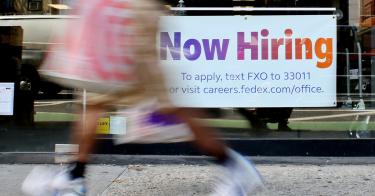The unemployment rate now matches the pre-pandemic, half-century low of 3.5 percent. But with 2.8 million missing workers, low unemployment is both a blessing and a curse.
There are millions more job openings than there are people looking for work. Employers have responded by creating more flexible workplaces, adding new benefits and expanding opportunities for people to advance upward—including opening doors for workers without college degrees. And annual wages are up nearly 7 percent (not including inflation) since January 2021.
But even as workers have benefited from an opportunistic labor market, they haven’t been immune from its consequences: shortages of goods and services, crowded emergency rooms, reduced public safety, delayed deliveries and higher prices. The average worker’s $3,600 pay raise since January 2021 is equivalent to a $3,000 pay cut after factoring in inflation.
And now, too few people in the workforce, which artificially reduces the unemployment rate, may also be a cause of the decline in gross domestic product in the first half of 2022.
>>> An Unprecedented Labor Shortage
Negative economic growth almost never happens alongside low unemployment. The last time that the U.S. economy experienced negative real GDP growth alongside unemployment below 4 percent was 1969. And that was followed by 25 years of sustained high unemployment, averaging 6.7 percent from 1970-1994.
As in 1969, the faltering economy can’t be explained simply by a lack of demand. Businesses have been struggling to fill open positions and to get the goods they needed to fill orders.
It’s supply that’s come up short.
There are 2.8 million fewer people working today than there would be if the employment-to-population ratio were the same as it was prior to the pandemic. That’s created a double whammy for the U.S. economy, and it doesn’t bode well for the future.
Employed workers produce goods and services that add to economic output, earn incomes that increase consumer spending, and save money that increases innovation and productivity. But would-be workers on the sidelines add nothing to output and usually take from it through government welfare benefits that subtract from other people’s paychecks and from private investment (when funded through government debt).
This worker shortage is the result of bad government policies that have caused a decline in the culture of work in America.
From day one, the Biden administration has been advancing policies that undermine work, diminish education alternatives and close doors to flexible work options.
The American Rescue Plan’s revival of super-sized and easily-available unemployment benefits 18 months after the pandemic began made it more lucrative for many people to remain unemployed than to work.
Instead of allowing flourishing new apprenticeship programs to simultaneously fill worker shortages and provide on-the-job paid education, the Biden administration canceled industry recognized apprenticeship programs on the basis that they were competing with the White House’s preferred government-monopoly model.
And now the administration is making it harder for people—many of whom are caregivers or struggle with health conditions of their own—to be their own bosses by redefining who is allowed to be an independent worker.
These policies are absolutely weighing the economy down, but their long-term implications are even more troubling. My ongoing analysis of this unprecedented labor market shows that young workers ages 20 to 24 have experienced 14 times the decline in employment as workers ages 25 to 54. And that’s happened even as college enrollment has plummeted.
>>> Could a Return of the Lost Workers Avert a Recession?
Work is crucial to economic growth, but it’s also fundamental to American society and to human flourishing.
President Bill Clinton quoted Robert Kennedy when he said: “Work is the meaning of what this country is all about. We need it as individuals, we need to sense it in our fellow citizens and we need it as a society and as a people.”
Continued low levels of employment will reduce the rate of economic growth, reduce real incomes, cause greater dependence on government social programs, require higher levels of taxation and exacerbate the U.S.’s already precarious fiscal situation.
But policies that create an environment where people want to pursue, and are able to expand, their productive capacities will increase economic output and boost personal incomes. They also empower people instead of politicians. And that’s what our economy really needs.
This piece originally appeared in MSN




